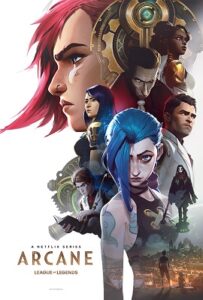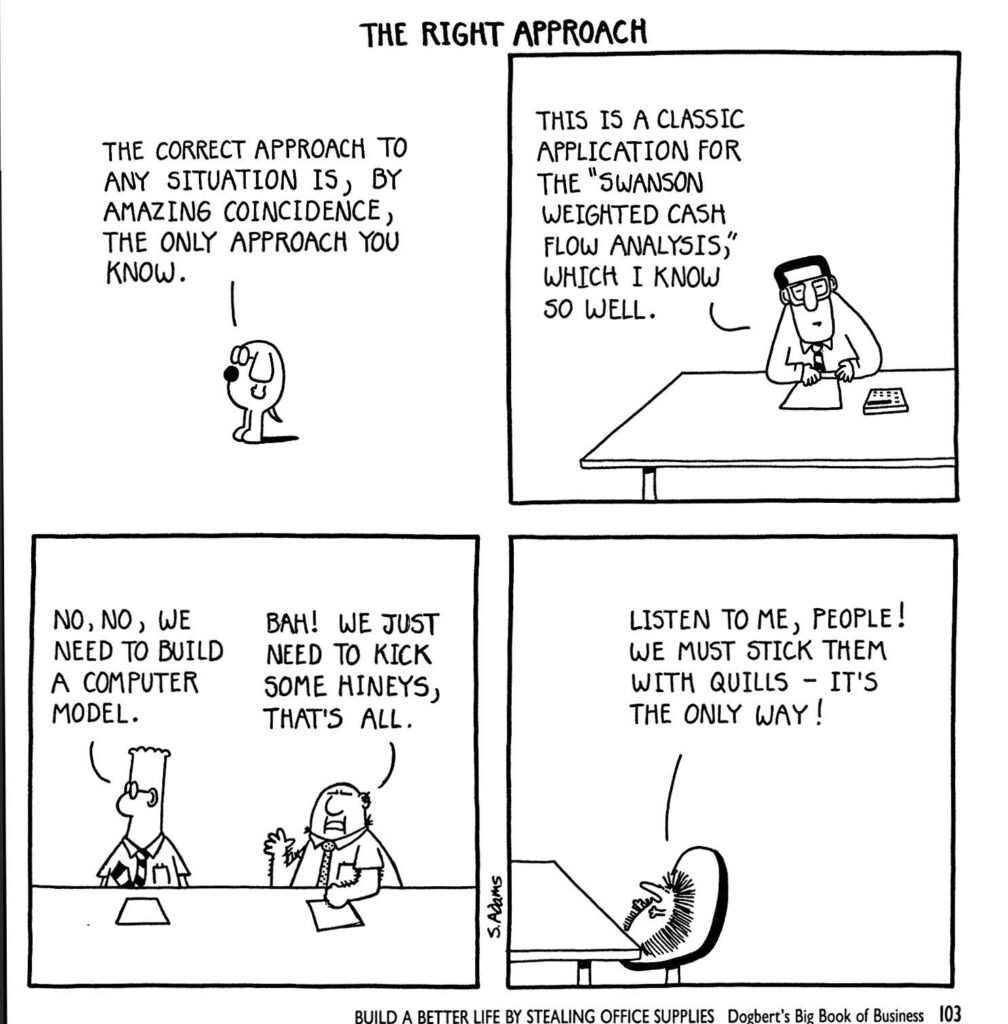 Today’s post is thanks to Ted the Awesome, who made an impassioned pitch for me to watch Arcane. And so I have. As you know, I do not play games very often, but had of course heard of League of Legends. Without knowing anything about the world, I guessed that this cartoon was meant to function as a kind of prequel, but this review will address it as a standalone story in its own right.
Today’s post is thanks to Ted the Awesome, who made an impassioned pitch for me to watch Arcane. And so I have. As you know, I do not play games very often, but had of course heard of League of Legends. Without knowing anything about the world, I guessed that this cartoon was meant to function as a kind of prequel, but this review will address it as a standalone story in its own right.
Arcane: League of Legends tells the story of two sisters brought up in the corrupt squalor of the slums of Zaun, and two idealist young scientists from the prosperous city across the bridge, Piltover. Vi and her sister Powder live hand to hand – as, it is implied, everyone in Zaun does. Zaun has various criminal organizations vying for superiority, but the syndicate run by Silco gets an advantage and Silco functionally takes over Zaun. Jayce is a privileged young man in Piltover who creates Magical “Hextech” gems, along with his partner Viktor. As the story progresses, they find that dreams and reality don’t match.
Now, let me say right up front that I did not enjoy Arcane for itself, but I did think it interesting. It gave me a lot to think about in terms of how stories are constructed and the shortcuts taken with popular culture writing like games and comics that people take for granted as providing depth without actually doing so.
To begin with part of the pitch for this series, was “how the systems of government (and lack there of) worked and how our heroes try to cope with wanting a better life and dealing with what life actually gives them. It’s not cookie cutter series where there’s a convenient end goal where once you’ve gotten it, everything will be better.”
And it occurred to me that white cis/het men who play games and consume media, probably have seen a grillion media forms that tell that story. You save the princess, get the item and You Win! (A process that has led generations of men who game to think of women as rewards rather than people, famously discussed by Arthur Chu in Your Princess is in Another Castle.)
As a queer woman, that that has never been the narrative I’ve been offered.
Almost every action narrative with a female lead starts with loss. Her family was killed, now she’s out for revenge! They “took everything” stories that begin with rape, poverty, enslavement, abandonment and loss, is the typical female lead story. Sometimes we get the Cassandra model, where the smart lady is ignored and everyone else on the ship gets an alien bursting out of their chest and dies. Remember, one of the reasons why shoujo manga took off so fast and so hugely in the 1990s in the west, was precisely because it gave us narratives of girls who were just girls doing their best. They cried when they were sad, and had friends they could lean on. They had agency and could make choices….all things that is still kind of rare in action media with female leads. In Age of Ultron, Black Widow’s entire character development was boiled down to her having being forcibly sterilized. Not that she killed a lot of people, brought down governments, caused untold suffering…she’s not able to bear children. That’s it. Like that’s the only thing women are about. Her inability to bear children is not just a de facto red mark on her ledger, but “a lot of red.” (Again, see Arthur’s above article about misogyny in nerdom.)
In this narrative, we are told a story about two sisters who are given zero opportunity to thrive. Every experience is trauma, loss, constant stress. It is not a different story than women experience in many places right here, right now. Poverty, illness, violence, mental illness…nothing about it is different. Absolutely cookie cutter, as it seems shockingly few men have the capacity to imagine anything else for women both in entertainment and real life.
So setting aside that children suffering loss as a plot driver is not compelling to me, the main concern I have with Arcane is that everyone in the story acts like a 15 year old thinks adults act. There are no actual adults in the cast. Just adult shapes, with simplistic thinking. It’s comic book villainy.
Don’t get me wrong, I see this in the real world, too, and it doesn’t seem to be obviously problematic to some portion of the population. Self-dealing is an extremely common form of political corruption. I was in a town planning meeting once when a council member who just *happened* to be a landscaper demanded the HVAC units of a new building be blocked off with a specific kind of tree which he just *happened* to have on hand. So the council of Piltover being self-concerned isn’t really the problem. The problem is that every scene with them is incoherent. They all reminded me of a Dilbert comic: “The correct approach to any situation is, by amazing coincidence, the only approach you know.”

The warrior argues for war, the logistics guy argues for (his) trade. Jayce comes in screaming but never says anything.
This is what I mean by no adult thinking: The Hextech. Those gems are going to make things better for people. How? Why? Why is it not obvious that it will just be taken by the privileged to given them more privilege. What problems do they solve? What problems do they create? No one asks or answers any of those questions. If Viktor thinks Hextech can help Zaun, why not just…give them to Zaun? Yes, I know why. But they just…never talk about any of it. Jayce shows up with Hextech, is made councilor and a scene later is the head of the council. This is not how politics, trade, economics or people…work.
All of this is a shortcut for pop culture writing. “Look, this is a complex society,” without thinking for a moment what is complex about it.
This carries over into the writing about Powder/Jinx. She’s a sweet innocent, until she snaps. As I watched Jinx fuguing I thought, “Oh, she’s Alice from Batwoman.” I’m not a mental health expert, I am not saying what happened to Jinx could not happen. I’m saying that a coherent narrative about mental illness, poverty and trauma is ignored for a 1983 music video with lots of neon instead.
The art style was interesting overall, a kind of magical deco for Piltover. (It’s not steampunk, which is more an aesthetic in which the Age of Reason and the Industrial Revolution have a Victorian baby.) This kind of Futurist Magical Deco in Piltover and Decrepit Industrial in Zaun, which immediately brought the setting (and the story) into comparison with Fritz Lang’s Metropolis. The animation was not bad, although typically, the settings and backgrounds were given a lush smooth quality the humans couldn’t quite get. I was very impressed with the animation of facial expressions. Used to anime, as I am, it was pretty amazing to see faces looking like…faces.
Lastly, you may have guessed that if I am reviewing this on Okazu, there is some lesbian aspect to the narrative…and so there is. In the course of the story a relationship is introduced for one of the protagonists. Vi meets up with this world’s version of a police officer, Caitlyn. Caitlyn is as privileged as Vi is disadvantaged and their relationship is antagonistic for some episodes. When they start to warm up to one another it is very reasonably presented as emotional intimacy that has potential to become more.
Sadly, the story again chooses a shorthand and Caitlyn is left to become no more than a catalyst for Vi and Jinx to resent each other. This frustrated me, as there was no point at all to the entire scene which becomes the climax for this story, setting up Vi and Jinx as opposing forces. Frustratingly, it was obvious that Caitlyn was put there as a puppy in the narrative for all the reasons mediocre writers put puppies in the narrative.
Of all the relationship choices in this story, the one that actually works the best was Silco’s relationship with Jinx. It felt very much like the creators were toying with the idea of crossing the line with them, but Silco consistently remained a father figure to Jinx right to the very end of the story. That surprised and pleased me and was legitimately the best-handled nuanced relationship in the whole story.
Overall, while I did not love Arcane, or find it entertaining, it gave me a lot to think about. I’m more aware of the kind of shortcuts – what I call handwaves – pop culture takes in world and relationship building….and I expect better. I want stories for adults to be written in a way that requires adult perception. I’m not saying I can’t get behind a teenage superhero or magical princess, but if you’re going to hand me a complex world, then I expect the creator(s) to be able to explain its complexities and then to do so.
Ratings:
Art – 9
Story – 5 It so easily could have been an 8, with a few screaming scenes removed and some thought put into it
Characters – 7 I wanted to like everyone, but I kept shouting “WHY?” at the TV
Service – 7 Nudity, which was fine and a long straight sex scene I could have done without.
Yuri – 4 It had potential, but…
Overall – 7
Thanks again to Ted, for giving me the opportunity to have a good long thought about what I want from my entertainment!
![]() Today’s review was inspired by a combination of two very different things. Various folks having mentioned this book in Yuri-friendly spaces online and, by complete coincidence, the fantastic podcast Mangasplaining putting it on their calendar, which caused me to bump this up on my to-read pile.
Today’s review was inspired by a combination of two very different things. Various folks having mentioned this book in Yuri-friendly spaces online and, by complete coincidence, the fantastic podcast Mangasplaining putting it on their calendar, which caused me to bump this up on my to-read pile.

